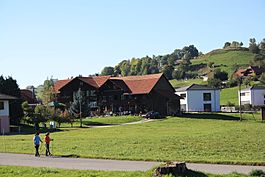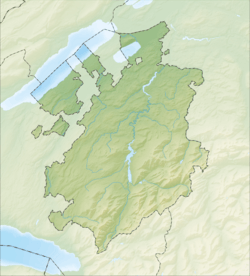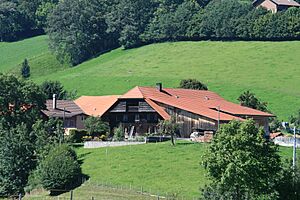Oberschrot facts for kids
Quick facts for kids
Oberschrot
|
||
|---|---|---|

Oberschrot village
|
||
|
||
| Country | Switzerland | |
| Canton | Fribourg | |
| District | Sense | |
| Area | ||
| • Total | 5.28 km2 (2.04 sq mi) | |
| Elevation | 850 m (2,790 ft) | |
| Population
(Dec 2015)
|
||
| • Total | 1,185 | |
| • Density | 224.43/km2 (581.3/sq mi) | |
| Postal code |
1716
|
|
| Surrounded by | Brünisried, Giffers, Plaffeien, Plasselb, Rechthalten, Zumholz | |
Oberschrot was a small town, also known as a municipality, located in the Sense district of the canton of Fribourg in Switzerland. It was special because most of its people spoke German, even though the Fribourg canton mainly speaks French. On January 1, 2017, Oberschrot and another nearby town called Zumholz joined together to become part of the municipality of Plaffeien.
Contents
History of Oberschrot
Oberschrot became its own independent municipality in 1831. Before that, the name "Oberschrot" referred to an area within the parish of Rechthalten. This area was made up of four smaller village parts, which were called Schrote.
Exploring Oberschrot's Geography
In 2009, Oberschrot covered an area of about 5.28 square kilometers (which is about 2 square miles). A big part of this land, about 56.1%, was used for farming. Forests covered another large portion, about 34.4% of the area.
About 7.7% of Oberschrot's land was built up with buildings or roads. A very small part, just 0.4%, was made up of rivers or lakes. Most of the built-up area included houses and other buildings. The rest was used for transportation, like roads.
The former municipality is located in the Sense district. It sits just north of a stream called Tütschbach. Oberschrot included several small villages, known as hamlets. These included Ried, Sahli, Gansmatt, Uf der Egg, and Plötscha. There were also many scattered farms throughout the area.
Understanding the Coat of Arms
The blazon (official description) of Oberschrot's municipal coat of arms is quite unique. It is described as Per fess Or a Semi Lion rampant issuant Azure and Gules a Fleur-de-lys Argent.
This means the shield is divided into two horizontal parts. The top part is gold (Or) and shows the top half of a blue (Azure) lion standing on its hind legs. The bottom part is red (Gules) and features a silver (Argent) Fleur-de-lys, which is a symbol often shaped like a lily flower.
Who Lives in Oberschrot? (Demographics)
In 2015, Oberschrot had a population of 1,185 people. Most of the people living there were Swiss citizens. In 2008, only about 3.2% of the population were foreign nationals.
Between 2000 and 2010, the population of Oberschrot grew by about 9.8%. This growth was mainly due to people moving into the area.
Languages Spoken in Oberschrot
In 2000, most people in Oberschrot spoke German as their main language, making up about 96% of the population. French was the second most common language, spoken by about 2.3% of the people. A small number of people also spoke English or Italian.
Age Groups and Families
In 2000, children and teenagers (up to 19 years old) made up 28% of Oberschrot's population. Adults (20 to 64 years old) were 57%, and seniors (over 64 years old) made up 15%.
There were 352 private households in Oberschrot in 2000, with about 2.7 people living in each home on average. Most of the apartments were lived in all year round.
Population Changes Over Time
The chart below shows how Oberschrot's population has changed throughout history:

Interesting Sights in Oberschrot
The village of Plaffeien, which Oberschrot shared, is a special place. It is recognized as part of the Inventory of Swiss Heritage Sites. This means it's an important historical and cultural area in Switzerland.
Oberschrot's Economy and Jobs
In 2010, Oberschrot had a very low unemployment rate of 1.1%, meaning most people who wanted to work had jobs.
Main Job Sectors
In 2008, many people worked in the primary economic sector, which includes jobs like farming and forestry. There were 52 people in this sector.
The secondary sector employed 108 people, mainly in construction. This means they built things.
The tertiary sector had 94 people working in it. This sector includes jobs like sales, working in hotels or restaurants, education, and healthcare. For example, many people worked in healthcare.
Commuting to Work
In 2000, 96 workers came into Oberschrot for their jobs, while 389 workers left Oberschrot to work in other places. This shows that more people from Oberschrot traveled out for work than came in. Most people (62.7%) used a private car to get to work, while a smaller number (8.7%) used public transportation.
Religion in Oberschrot
According to the 2000 census, most people in Oberschrot were Roman Catholic, making up about 85.6% of the population. About 6.3% belonged to the Swiss Reformed Church. A small number of people belonged to other Christian churches or were Islamic. Some people also stated they had no religion, being agnostic or atheist.
Education in Oberschrot
In Oberschrot, about 32.9% of the population had finished non-mandatory upper secondary education. This means they completed schooling beyond what was required. About 5.8% had gone on to higher education, either at a university or a specialized college called a Fachhochschule.
The Swiss School System
The Canton of Fribourg has a specific school system:
- It starts with one year of optional Kindergarten.
- Then, students attend six years of Primary school.
- After Primary school, there are three years of required lower Secondary school. Students are grouped based on their abilities.
- Following lower Secondary, students can choose to attend an optional three or four-year upper Secondary school. This can be a gymnasium (which prepares students for university) or a vocational program (which teaches skills for specific jobs).
- After upper Secondary, students can go to a Tertiary school or continue with an apprenticeship (learning a trade on the job).
Schooling in Oberschrot (2010-2011)
During the 2010-2011 school year, 34 students attended 2 classes in Oberschrot. However, many students from Oberschrot went to schools in neighboring towns. For example, 23 students went to kindergarten in a nearby municipality. Also, 63 students attended lower secondary school, 13 upper secondary students, and 32 vocational students went to schools outside Oberschrot.
In 2000, 21 students came to Oberschrot from other towns to go to school. At the same time, 119 students from Oberschrot went to schools in other municipalities.
See also
 In Spanish: Oberschrot para niños
In Spanish: Oberschrot para niños






